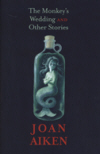The Monkey’s Wedding and Other Stories
British author Joan Aiken died in 2004, leaving behind a huge volume of work, including over a hundred books. She began with short stories, and this collection of nineteen tales is a fun introduction to Aiken’s quirky, imaginative style. The word “tale” is particularly apt for these stories; many of them read like old folk tales handed down through generations.
British author Joan Aiken died in 2004, leaving behind a huge volume of work, including over a hundred books. She began with short stories, and this collection of nineteen tales is a fun introduction to Aiken’s quirky, imaginative style. The word “tale” is particularly apt for these stories; many of them read like old folk tales handed down through generations.
For example, here’s the opening line to “Girl in a Whirl”: “Her name was Daisy and she was a smasher, the crispest colleen in Killyclancy.” With an opening like that, the reader might be expecting a tale of a charming milkmaid in a rural village. But this is Aiken, queen of the unpredictable, so Daisy is not a milkmaid, but a stunt rider who rides a motorbike round and round inside a metal cage. In another story, a woman stranded on a deserted island learns to communicate with some very sophisticated mice that enjoy discussing philosophy. In my favorite story, “Red Hot Favourite,” a nearsighted misogynist loses his glasses, and finds the perfect woman.
Aiken’s versatility gives the collection tremendous variety. Some stories, like “Water of Youth” and “The Sale of Midsummer,” have a fairy-tale feel; others are reminiscent of creepy tales you’d tell around a campfire with a flashlight under your chin (“Wee Robin,” for instance, opens with, “This story was told me by my aunt Martha,” and tells of a little boy who mysteriously appears and disappears in the home of a Countess). A few stories, however, are achingly sad and poignant, such as “Hair,” the story of a man whose young wife dies while on their honeymoon, and the title story, “The Monkey’s Wedding,” in which an elderly woman loses her beloved son and discovers a grandson she never knew existed.
Aiken clearly had a wild imagination, but it is her skill as a writer that makes her odd yarns so engrossing. For instance, in this passage, the young widower in “Hair” thinks of his departed wife:
Matter can neither be created nor destroyed, he thought. Not matter, no. The network of bones and tendons, the dandelion clock of fair hair, the brilliantly blue eyes that had once belonged to Sarah, and had so riotously obeyed her will for a small portion of her life—a forty-second part of it, perhaps—was now quietly returning to earth in a Christian cemetery in Ceylon. But her spirit, the fiery intention which had coordinated that machine of flesh and bone and driven it through her life—the spirit, he knew, existed neither in air nor earth. It had gone out, like a candle.
Contrast that passage with the opening of “Water of Youth”:
Gay and glorious, one day every year, the market square of this little town is, and that’s the day in September when the fair comes, and music peals, and roundabouts whirl, and the through-traffic, if it wants to get by, has to give the town a miss and scrape along side lanes past sodden blackberry hedges.
This versatility is reflected throughout her career; she wrote stories for literary and women’s magazines, as well as dozens of children’s books, including the popular “Wolves of Willoughby Chase” series.
The collection includes an introduction by Aiken (written in 1995) and a longer, biographical introduction by her daughter Lizza. In the author’s introduction, Aiken claims that many of her stories are inspired by dreams. I only wish my dreams were half as entertaining as Aiken’s tales.





